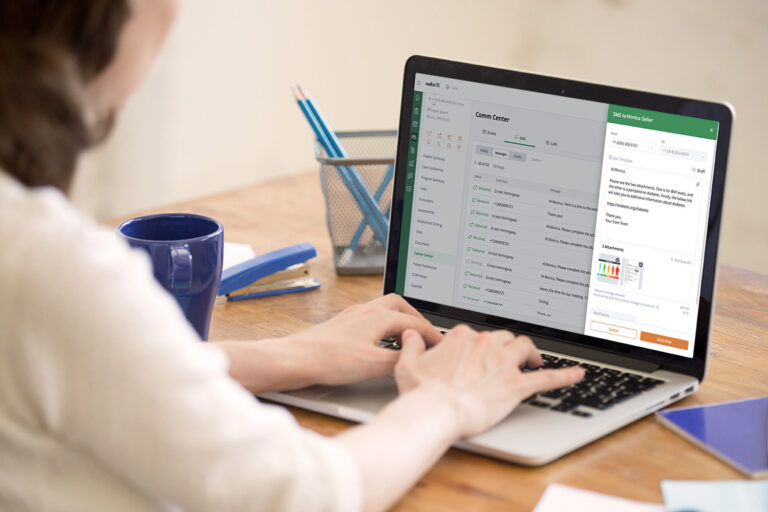E-prescribing is the electronic transfer of a patient’s prescription directly to the pharmacy. Clinicians who e-prescribe can do so securely and easily using a tablet or computer. E-prescribing has many benefits, like streamlining the prescribing process for providers, speeding up communication with the pharmacy, reducing errors, and ensuring patients receive the medication they need quickly.
As care management software evolves, it’s easier than ever to incorporate e-prescribing and leverage it to its full potential. Centralized data in care management platforms provides a comprehensive view of each patient, allowing prescribers to see patient history, previous diagnoses, and current medications. This capability decreases the risk of errors, improves patient safety, and reduces the administrative burden on providers and care teams.
Understanding the e-prescribing process
E-prescribing modernizes, automates, and streamlines traditional paper-based prescribing. It replaces the process of a provider handwriting a prescription, handing it over to a patient, and having the patient bring the prescription to a pharmacy to learn if a pharmacist can fill it. Instead, prescribers can enter prescription information into a tablet or computer and transmit the prescription to a pharmacy securely and instantly.
E-prescribing platforms can integrate with a practice’s electronic health record (EHR), care management platform, healthcare CRM, or simply be used as a stand-alone system. The e-prescribing platform connects to a vast network of pharmacies, integrates patient health records, and verifies insurance coverage.
Providers enter information about a prescription, including the brand name, whether a generic is acceptable, dosage, and patient instructions. Once all information is entered and verified, the e-prescribing platform sends the prescription to the pharmacy to fill it.
Benefits of e-prescribing over traditional paper-based prescribing
Studies show that e-prescribing reduces prescribing errors, increases efficiency, and helps to save overall costs. As e-prescribing expands, there are many benefits for providers, care teams, patients, and the broader healthcare system.
Convenience
E-prescribing reduces the time and human effort associated with bringing a paper prescription to the pharmacy, learning if the medication is in stock, and waiting for the pharmacy to fill the prescription. Prescriptions are sent directly and instantly, and if questions or concerns arise, the pharmacist can communicate directly through the platform with the prescriber and care team.
Improves health equity
Patients who experience health inequities based on race, disability status, or health status should have the same access and standard of care as any other patient. By reducing the time patients wait for prescriptions and streamlining the prescription process, e-prescribing improves health equity.
Decreases prescription and medication errors
Utilizing an e-prescribing platform eliminates hard-to-decipher handwriting of drug names, dosages, and frequency. E-prescribing platforms also notify prescribers and pharmacists when potential drug interactions are identified. Reducing preventable errors improves patient outcomes and eliminates avoidable complications.
Reduces paperwork
E-prescribing greatly reduces the administrative burden of physically writing and tracking prescriptions, as well as updating patient charts and records. Streamlining the prescription process gives back more time to providers and care team members to spend with patients. Integrated e-prescribing platforms also automatically update patient EHRs and ensure all providers and care team members are up-to-date on patient medication.
Improves patient safety
The integration of e-prescribing platforms with patient EHRs gives providers a comprehensive view of a patient’s health history, current medications, and related information. Providers and care teams can quickly confirm whether there are potential drug allergies or drug interactions with current prescriptions. The transmission of electronic prescriptions also ensures that pharmacies have clear and complete information to fill the request accurately. Reducing the chance of prescription errors enhances patient safety and outcomes.
Cuts costs
E-prescribing lowers healthcare costs by identifying opportunities to substitute for generic medications and ensuring patients have access to needed prescriptions. With e-prescribing, patient medication adherence increases, allowing care teams to manage medical conditions better. When patients can obtain and adhere to their prescriptions, they have better health outcomes and are less likely to experience costly complications or adverse events.
Regulatory requirements for e-prescribing
With e-prescribing, prescribers can electronically send accurate, error-free prescriptions directly to a pharmacy from a site of care. The technology that supports this process is subject to scrutiny by federal and state regulators. E-prescribing technology must align with all statutory and regulatory requirements for electronic prescription transmission. Notably, the Code of Federal Regulations Part 1311 outlines specific requirements that must be met. The e-prescribing technology must provide all of the following:
Authentication: the system must ensure the prescriber’s identify has been properly verified for the dispensing pharmacy
Nonrepudiation: the system must ensure that strong evidence proves the prescriber’s identify
Message Integrity: the system must ensure that any alteration of the information transmitted can be detected
E-prescribing helps providers and care teams keep their patients’ safety and health at the forefront of care with every prescription. More than 1 in every 3 Americans is covered by a federal health insurance program through Medicare or Medicaid. Prescribers can expect federal requirements around e-prescribing to expand beyond the current state.
The federal SUPPORT Act passed in 2018 requires that all clinicians prescribe Medicare Part D Schedule II-V controlled substances electronically. As of January 1, 2023, e-prescribing for controlled substances for Medicare Part D and Medicare Advantage prescription plans is now enforced. Prescribers are required to prescribe controlled substances electronically and register with the DEA.
Integrating e-prescribing into your care management system
Your organization can integrate e-prescribing systems with care management platforms to seamlessly connect with patient records, providing better patient care and experience. Care management platforms streamline and optimize workflows and communication for providers and care teams and support enhanced communication with patients. When a patient’s record is housed in the same system used to prescribe or refill medication, providers are able to access a patient’s health history, recent encounters, and adherence to existing prescriptions. With this information at their fingertips, prescribers can write a more informed and safer prescription.
What should healthcare organizations consider when choosing a platform to integrate with e-prescribing? The first step is to identify a care management platform that allows integrations to support one-stop, unified care management. Welkin offers a custom-built care management solution that meets the unique needs of providers and care teams. With API-first development, Welkin’s platform is designed to function and integrate with existing software to deliver outcome-driven care.
For instance, Welkin ‘s integration with DrFirst provides access to multiple e-prescribing products to help you have a more well-rounded patient environment.
E-prescribing is here now
Providers and care teams are accelerating the option to integrate e-prescribing with their care management platforms to streamline workflows, improve patient outcomes, and meet state and federal requirements. E-prescribing offers convenience to prescribers, patients, and pharmacies, improves health equity, decreases prescription and medication errors, reduces paperwork, improves patient safety, and cuts costs.
The shift to e-prescribing also allows technology to validate prescriber identity and prescriptions and is now required for all controlled substance prescriptions covered by Medicare. Expansion of these requirements is also underway in certain states and is expected to continue.
Integrating a care management platform with e-prescribing technology empowers providers and care teams with all of the necessary information, connectivity, and security to meet state and federal requirements and make prescribing more convenient. Welkin offers a customizable approach for healthcare organizations, and its native integration with DrFirst provides a flexible e-prescribing solution that providers can incorporate into existing workflows. Schedule a demo with us to learn more about how Welkin can help make your program more care-centric today!


